#Ivy Ogham
Text
Strength of Ivy
Hello and welcome to the 11th (lunar) month of the year on our ‘Celtic Tree Calendar’ , ‘the month of Ivy‘ which begins tomorrow (September 30th) and takes us through to October 27th .. 🙂
Now although, technically speaking, not a tree, Ivy uses trees to support its growth by way of a ruthless tenacity and power so strong, it can sometimes even kill its host!
So tough is this plant that a very…
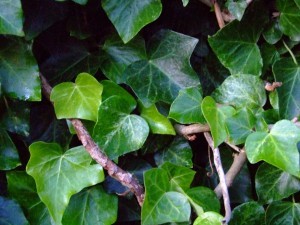
View On WordPress
0 notes
Photo

Legends and myths about trees
Celtic beliefs in trees (6)
Ogham alphabet and tree calendar
The Ogham alphabet is the most ancient Irish writing script. There, every letter of the alphabet is associated with the name of a tree, and for this reason, ogam is sometimes known as the Celtic tree alphabet.
The ogham script was a secret means of communication for the druids and also a key to the spirit world.
There are roughly 400 surviving orthodox inscriptions on stone monuments throughout Ireland and western Britain, the bulk of which are in southern Munster. The largest number outside Ireland are in Pembrokeshire, Wales.
Details of the Celtic tree calendar are as follows:
B for Beth (Birch) - December 24th - January 20th
L for Luis (Rowan) - January 21st - February 17th
N for Nion (Ash) - February 18th - March 17th
O for Onn (Golden Gorse) - March 21st Spring Equinox
F for Fearn (Alder) - March 18th - April 14th
S for Saille (Willow) - April 15th - May 12th
H for Huath (Hawthorn) - May 13th - June 9th
D for Duir (Royal Oak) - June 10th - July 17th
U for Ura (Heather) - June 21st Summer Solstice
T for Tinne (Holly) - July 18th - August 5th
C for Coll (Hazel) - August 5th - September 1st
Q for Quert (Apple) - September 2nd - September 29th
E for Eadha (Aspen) - September 21st Autumn Equinox
G for Gort (Ivy) - September 30th - October 27th
Ng for Ngetl (Broom) - October 28th - November 24th
Ss for Straif (Blackthorn) - Samhain/Hallowe'en
R for Ruis (Elder) - November 25th - December 21st
I for Idho (Yew) - December 21st Winter Solstice
A for Ailm (Pine) - December 23rd Birth of the Divine child
Ph for Phagos (Beech) - all year around

木にまつわる伝説・神話
ケルト人の樹木の信仰 (6)
オガム文字と木の暦
オガム文字は、最古のアイルランドの表記文字 (アルファベット)。そこでは全てのアルファベットが木の名前と結びついており、このため、オガム文字はケルトの樹木のアルファベットと呼ばれることもある。
オガム文字はドルイドにとって密かな伝達の手段であり、また霊の世界に導く鍵でもあった。
アイルランドとイギリス西部の石碑には、約400の正統派の碑文が現存しているが、その大部分はマンスター南部にある。アイルランド以外で最も数が多いのは、ウェールズのペンブルックシャーである。
ケルトの木の暦の詳細は以下の通り:
B は Beth (シラカバ) - 12月24日~1月20日
LはLuis (ナナカマド) - 1月21日~2月17日
NはNion (トリネコ) - 2月18日~3月17日
OはOnn (ハリエニシダ) - 3月21日・春分の日
FはFearn (ハンノキ) - 3月18日~4月14日
SはSaille (ヤナギ) - 4月15日~5月12日
HはHuath (サンザシ) - 5月13日 - 6月9日
DはDuir (ロイヤル・オーク) - 6月10��~7月17日
UはUra (ヒース) - 6月21日・夏至
TはTinne (ヒイラギ) - 7月18日~8月4日
CはColl (Hazel) -8月5日~9月1日
QはQuert (リンゴ) - 9月2日~9月29日
EはEadha (ポプラ) - 9月21日・秋分の日
GはGort (キヅタ) - 9月30日~10月27日
NはNgetl (エニシダ) - 10月28日~11月24日
SはStraif (リンボク) -サムハイン/ハロウイーン
RはRuis (ニワトコ) - 11月25日~12月21日
IはIdho (イチイ) - 12月21日 冬至
AはAilm (マツ) - 12月23日 神の子の誕生
Ph は Phagos (ブナ) - 1年中
#celtic mythology#celts#trees#tree folklore#tree myth#forklore#ogham#ogham alphabet#tree calender#philosophy#nature#art
128 notes
·
View notes
Text
Ogham
Third Aicme (M)
by autumn sierra
For digital formatting purposes, the Ogham have been rotated 90° to the right into horizontal form. When rotated 90° to the left, they will again be in vertical form.
Ogham Master Post
ᚋ
Muin (m): Blackberry/Bramble
Meaning: psychic powers, prophecy, patience, release logic & reason, examine life lessons, emotional communication
ᚌ
Gort (g): Ivy
Meaning: transformation, exploration, career, education, cultivated sanctuary
ᚍ
nGétal (ng): Reed
Meaning: order from chaos, harmony, will, action, awareness, active healing
ᚎ
Straif (z): Blackthorn
Meaning: fate, fortune, trials of change, liberation, rebirth
ᚏ
Ruis (r): Elder tree
Meaning: look ahead, letting go, change, renewal, career, health, controlling power
#gaidhlig#scottish#gaelic#gaeilge#irish#ancient celts#witchblr#witch community#folk witchcraft#witchcore#green witch#witch#witches#witchcraft#witch aesthetic#irish language#celtic#ogham
9 notes
·
View notes
Text
Vrinda: The Ivy Queen
Exploring the connections between the Norse goddess Rindr/Vrinda and ivy folklore
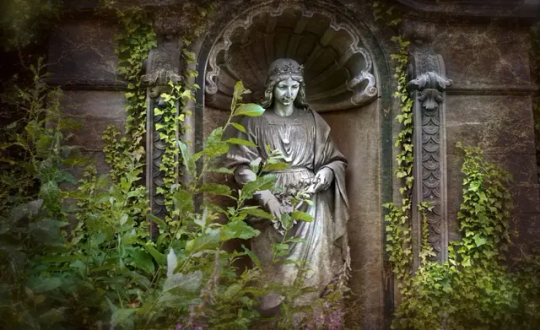
I am writing this with my mind swathed in a dark emerald green. Last Yule night I drew the rune Gebo, the Ivy card from my Ogham deck and the Queen of Swords. This painted an interesting picture in my head, of a green lady wandering amongst ivy-clad ruins. I dived into ivy folklore and mythology, researching who this might be. I visited Hebe, the Maenads and the various Green Ladies of Britain, but one particular solemn figure was sitting and waiting for me.
Very little is known of the Goddess Rindr and her name’s origin is obscure, but it is thought to be connected to a Gotlandic word for ivy, rind. A variation of her name, Vrindr, Wrinda or Vrinda (the name I prefer), can possibly be found in the Ostergotland place name Vrinnevi, the meaning of which would in that case be Vrindar-Vé (Vrindr’s Shrine). Oscar Lundberg proposed that she was therefore a fertility goddess represented by ivy or perhaps even made of it. The theory of her being connected to Vrinnevi has been debated, and some argue that the place name simply means “Ivy forest”. Even so, the similarity between the name Rindr and the word rind is hard to ignore and I strongly feel that she is represented by ivy as Lundberg suggests. Previously I had only known her as some kind of winter goddess and as the unwilling bearer of Óðinn’s son, Váli. This connection to the ivy plant opened up a whole new dimension of her.
I want to start by criticizing Patricia Telesco’s interpretation of Vrinda being a goddess of accepting uncomfortable changes. That just as winter yields to spring, so does Vrinda yield to the advances of Óðinn and become warm and fertile. Whether or not Vrinda’s myth is a metaphor for the changing of seasons, I find it appalling that someone would look at a story about sexual assault and draw from it the lesson that one should not fight “positive change”. Change can be good, but that attitude in this context is disgusting and disrespectful to all that have had to go through such a horrible experience. Now, moving on…

First there is the madness. The maenads were wild, ecstatic worshipers of Dionysus who wore ivy. Often willing participants of the frenzy, but sometimes forced. In Gesta Danorum the tale is told of how Óðinn, when thrice rejected by Vrinda, uses magic to drive her mad and then ill. Disguised as a medicine woman called Wecha, Óðinn tells her father that he can cure her but it would cause a violent reaction. Vrinda is tied to her bed and Óðinn proceeds to commit one of his ugliest crimes. I connect these two instances of forced madness with certain properties of the ivy; ingesting the leaves can cause delirium, convulsions and even hallucinations. Surprisingly, wearing crowns of ivy was believed to prevent drunkenness. To me, all of the above makes Vrinda a goddess of madness, but as a sufferer. We who may have bouts of bad mental health may find comfort in her.
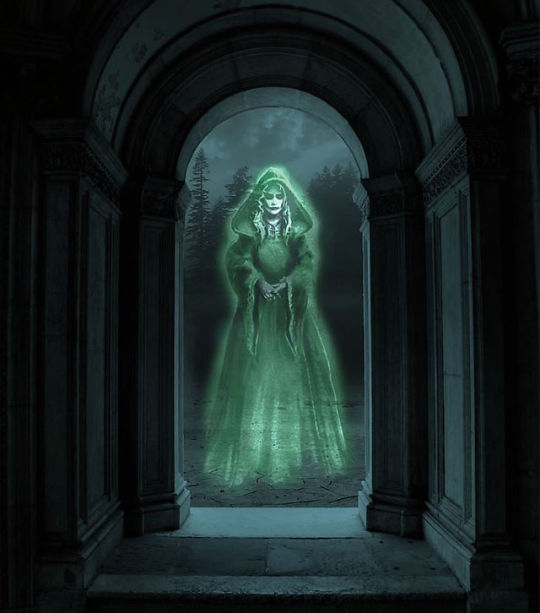
Next I want to talk about the Green Ladies of Britain, specifically the melancholy yet usually benevolent ghosts that haunt castles. The Green Ladies are dead but are still kind, often protecting living residents of their haunts. The Green Lady of Huntingtower Castle in Perthshire (known as Lady Greensleeves) is said to have healed a young boy who lived in a house on the estate. Ivy was also seen as a protective plant in Britain.This protective element also be a domain of Vrinda, John McKinnell writes about a kenning for a warrior in the saga of Guðmundur Arason, serkja Rindar Sannr. Sannr is a name of Óðinn meaning “truth”, Rindar serkur would be “Rindur’s serk”. According to McKinnell this hints that she may have been able to enchant clothing to work as a protective charm. But back to the Green Ladies. Most of them are thought to be the ghosts of particular women of noble lineage that lived in the castles and were usually killed in horrible ways. The Green Lady of Caerphilly Castle is the ghost of Alice de la Marche of France who died of shock when she learned of her husband’s men killing her lover. I mention her specifically because of her ability to blend into the ivy that grows on the castle walls. The ivy in this story feels like a very appropriate symbol and I feel it could be extended to the rest of the Green Ladies. Ivy clings to ruins, it clings to trees long after they die. I want to quote the first stanza of Henry Kendall’s The Ivy on the Wall:
The verdant ivy clings around
Yon moss be-mantled wall,
As if it sought to hide the stones,
That crumbling soon must fall:
That relic of a bygone age
Now tottering to decay,
Has but one friend—the ivy—left.
The rest have passed away.
I believe this sentiment lives with Vrinda. In this aspect, she is a goddess of mourning and trauma, of yearning for the irretrievable past. But at the same time she is a goddess of protection and overcoming hardships and devastation. As ivy holds together and decorates the weathered stones of an old castle, so too can Vrinda help hold together our broken hearts and shattered selves.

Then there is winter. I have read many articles and blogs online written by pagans associating Vrinda with winter and almost nothing else. I never actually saw mentioned any concrete reason for it, but now that I have become aware of her ivy realm it has become obvious. Most people are familiar with the carol The Holly and the Ivy. Both plants are evergreen and are part of a family of yule plants alongside mistletoe and yew. Ivy and Holly historically represented the feminine vs masculine, in parts of England there are still dances between the Holly boy and the Ivy girl. It was supposedly custom once for men and women to light-heartedly taunt each other through song. Sadly it seems mostly the songs praising Holly have been preserved, an example is the following verse:
Nay, Ivy, nay; it shall not be i-wys ;
Let Holly hafe the maystery, as the manner is.
Holly stond in the Halle fayre to behold;
Ivy stond without the dore; she is full sore acold.
Holly and his merry men they dancyn and they sing.
Ivy and hur maidens they wepyn and they wryng.
(Ballad from the time of Henry VI)
In a more positive light, holly and ivy feature in a poem by Henry VIII called Green Groweth the Holly. Here ivy's steadfast color throughout winter symbolizes fidelity. It is a charming poem if a bit ironic, since Henry himself wasn’t exactly a paragon of fidelity. I’ll let you read the third and fourth verse:
As the holly groweth green
With ivy all alone
When flowers cannot be seen
And greenwood leaves be gone,
Now unto my lady
Promise to her I make,
From all other only
To her I me betake.
It is not strange that Henry made this connection. In the language of flowers ivy represents fidelity, wedded love and friendship. Ancient Greek brides would carry ivy as a symbol of undying love and sprigs of it are often found in wedding bouquets today. I think ivy being an evergreen as well as it’s ability to cling tightly are good reasons for it being a symbol for faithful love. We also see generosity and kindness as ivy provides berries for birds in winter. These aspects all together give me the feeling that, yes, Vrinda is a winter goddess. However, I feel she is more a goddess of persevering winter, rather than a goddess of the frost and cold itself. She stays living, green and fruitful when other plants lie dead. Her love persists through hardships. Winter or summer, it holds on.
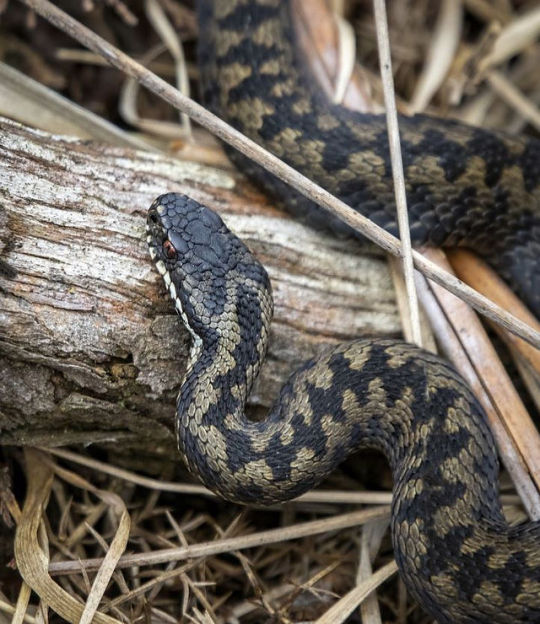
Just before I conclude I’d like to touch upon animal associations. There is not a lot to work with, but the color and winding tendencies of ivy invoke the spirit of a serpent. Perhaps an adder, with its ivy-like pattern and ability to hibernate. The adder, like the ivy, is also toxic. The maenads wore serpents as well as ivy so it's not entirely far-fetched to see snakes as a favorite of Vrinda, but I’m not sure how well it fits. Perhaps the wren, a bird often seen darting through ivy bushes and has connections to winter. The word “wren” is of obscure origin but the words wren, rind (the Gotland word for ivy) and rindill (the Icelandic word for wren) sound curiously similar to Wrinda and Rindur.

Then there are owls. In Britain ivy has a special relationship with the tawny owl, which is sometimes even called an ivy-owl. Most people are familiar with owls being traditionally associated with death, but it may surprise some that ivy is so as well. This seems contradictory to it’s tolerance of winter, the death of the year, but this association likely stems again from fidelity as well as ivy’s tendency to grow over tombstones. Ivy was also a frequent motif on headstones and there it likely represents immortality and eternal life. Both snakes and owls are carved on headstones too. Ivy was also used to foretell death.

This association with death ties well in with the aforementioned Green Ladies. Owls and ivy are paired together in the idiom “like an owl in an ivy-bush”, which is used to describe a person with a vacant stare (usually due to drunkenness) or in some cases those with a frightened and dishevelled appearance. I almost forgot to mention that tawny owls usually mate for life, fidelity again. Finally, the carol I mentioned earlier has a couple of verses mentioning owls:
Ivy hath berries black as any sloe;
There come the owl and eat him as she go
…
Good ivy, what birds hast thou?
None but the owlet that cries how, how.
That brings us to the end. It’s quite bold of me, I know, to just give Vrinda all these associations purely based on ivy folklore and mythology. However, I feel so uncomfortable just leaving her bound to that one, grisly story of her impregnation. It’s unfair. I really do feel she may have shown herself to me that Yule night, or at least an aspect of herself, and I’d rather she lived in my mind as a lush and complex entity. Maybe I am getting lost in a thick forest of wishful thinking but maybe, like the Green Lady of Caerphilly Castle, she has indeed been hiding in the ivy.
Vrinda the broken, Vrinda the crazed,
Vrinda the wanderer of ruins and graves.
Vrinda the devoted, Vrinda the evergeen.
Vrinda the beautiful, unwavering Ivy Queen

Hrafnsunna Ross
Sources and further reading:
On English ivy folklore and mythology:
http://khkeeler.blogspot.com/2021/10/plant-story-folklore-of-english-ivy.html
https://interestingliterature.com/2021/05/ivy-symbolism-in-literature-religion-mythology-analysis-meaning/
https://from-bedroom-to-study.blogspot.com/2012/12/the-hedonistic-history-of-interesting.html?m=1&fbclid=IwAR3kerXYa_Nud94rzbCuhPlv-qH8Dah2R2jibqFLPYV4d8GmGTP87GJgVBQ
https://books.google.is/books?id=eOvyDwAAQBAJ&pg=PA118&lpg=PA118&dq=ivy+drunkenness+folklore&source=bl&ots=n3L6TNUO9e&sig=ACfU3U1PGGIezufv-sZbxklBhjBdNuqwKw&hl=en&sa=X&ved=2ahUKEwjDi6SxgYT1AhWTEMAKHcEyBN4Q6AF6BAg0EAM#v=onepage&q=iv
y%20drunkenness%20folklore&f=false
https://speakingofwitchwands.net/2017/11/16/the-magick-of-ivy/
https://www.woodland-ways.co.uk/blog/hedgerow-medicines/ivy/
Properties of English ivy:
https://plants.ces.ncsu.edu/plants/hedera-helix/
On Maenads:
https://www.thecollector.com/maenads-women-bacchus/ On Green Ladies: https://www.spookyisles.com/scottish-green-lady-stories/
Wedding flower customs:
https://www.theknot.com/content/wedding-flowers-customs-traditions
Wren:
https://www.etymonline.com/search?q=rindill
https://www.bardsinthewoods.com/2012/12/the-wren-wren.html
Tawny Owl:
https://www.peakdistrictonline.co.uk/birds-of-prey-the-tawny-owl/
Evidence pointing to Rindr being a worker of protective magic:
https://secureservercdn.net/198.71.233.138/16i.962.myftpupload.com/wp-content/uploads/2019/07/John_McKinnell_Meeting_the_Other_in_Norse_Myth_ab-ok.cc.pdf
https://norse.ulver.com/src/biskup/gudmunda/index.html
Gesta Danorum book 3, where the story of her assault is written:
https://www.gutenberg.org/files/1150/1150-h/1150-h.htm
Possible etymology of her name:
https://books.google.is/books?id=DtcMCAAAQBAJ&pg=PA160&lpg=PA160&dq=scandinavia+ivy+goddess&source=bl&ots=GMILPvloOP&sig=ACfU3U3EX9SDhIxFUwiTT_sNHFbMbxOlng&hl=en&sa=X&ved=2ahUKEwjv-_fXvYP1AhUwQEEAHdY1D9cQ6AF6BAgfEAM#v=onepage&q=scandinavia%20ivy%20goddess&f=false
Headstone symbolism:
https://headstonesymbols.co.uk/
#norse paganism#pagan#heathen#witch#Rindr#Rindur#Wrinda#Vrindr#Vrinda#trees and forests#ivy#folklore#mythology#norseheathen#norse deities#norse mythology#owl#wren#tawny owl#adder#winter#mine#theory
12 notes
·
View notes
Note
hey, just wanted to express appreciation and gratitude for your ogham post series. they're really helping me so much to learn interpretation of the feda! the clarity and thoroughness of your profiles for each stave present the information so well and give options for interpretation that other sources lack, so thank youuuu
also hoping/wondering whether you could clarify a reading I've done for myself? my draw was a simple linear three stave, for past present and future. the order was Huathe--Gort--Beith, which to me presents a contradiction in terms? moving from the caution and fear of Hawthorn to the dynamic powerful position of Ivy is possible, but hasn't happened in my personal trajectory, as I've been more or less avoiding the bad situation with this past/problem person. so what does that signify? and as for Birch in the result/future, this situation is kind of a dead end and has no positive or fruitful creative new solution that I can see, so how could this ogham be enacted? it's so confusing
for context: the question I asked the staves and the Gods (I am not a devotee yet, just venerating the Brythonic pantheon) was--how to get over a long-term dormant and unresolved issue I've been having with someone (who is in town this weekend after an absence of years), and to move on and forward with my highest good.
this past person is younger, close to my family, and got psychologically ill when we were still teens and he was living with me & my parents (who got him back to full health at great personal cost), which traumatised me and left me neglected at the time. it still gets to me that he's never bothered apologising or even explaining it. we also once had a mutual physical crush we never acted on when we were kids, the energy of which still lingers in our dynamic even though we no longer talk or see each other much and have other partners. he's living a fun successful abundant life he can be proud of now and I'm not, and it's creating emotional issues, fear and anger blockages for me that therapy hasn't helped with. hashing it out and being honest isn't really an option for us, sadly, so idk what to do.
any insight or advice on how to apply the meanings of these feda would be so appreciated. hope your weekend is amazing x
I'm glad the series helped you! I apologize for letting this sit in my inbox for so long; I've just returned from a trip.
Just to start with, I've found that it's much easier to interpret ogham by casting them like bones or runes rather than pulling them like tarot cards. The spatial arrangement and positions of the different feda can often provide clarity to their meanings and relationships to one another.
That being said, let's break down what you've drawn:
Uath is strongly associated with fear and pain, which sounds like it echos some of your past experiences with this individual. This fid can also suggest a need to reevaluate your current path.
Gort represents represents a safe haven where you can find comfort, peace, and personal growth. You mentioned therapy, which could be indicated here, but it could also be any area in your life where you feel a similar sense of peace and security.
Beith is associated with new beginnings, personal growth, protection, and purification.
Considering everything you've shared and the feda drawn, it appears to be a call to reassess your relationship with this person and how you perceive your past with them.
In your message, you mentioned that this person has not apologized to you. However, what struck me is that the issues you mentioned—their developing mental illness and your parents neglecting you to care for them—seem like circumstances beyond their control.
The fid you drew for the past, Uath, also hints that some of your pain and anger may be misdirected. The responsibility for meeting your needs as a child rests with your parents. If your parents neglected you, even if their intention wasn't to do so, they are the ones who owe you an apology.
You expressed not being proud of the life you're living now in comparison with this other person. Gort suggests that you should grant yourself peace and freedom from the burden of comparing yourself to them. If necessary, consider unfollowing or muting them on social media, and focus on defining your own goals and the way you want to live, rather than competing with or opposing this other person.
Drawing Beith as the future is, to me, a hopeful sign that with some distance and effort, you can find a way forward in your relationship with this person. Spending some time to prioritize yourself and untangle where your feelings of anger and hurt truly originate, rather than fixating on this individual will hopefully bring you some relief.
2 notes
·
View notes
Text
I struggle to feel qualified to do my own readings…
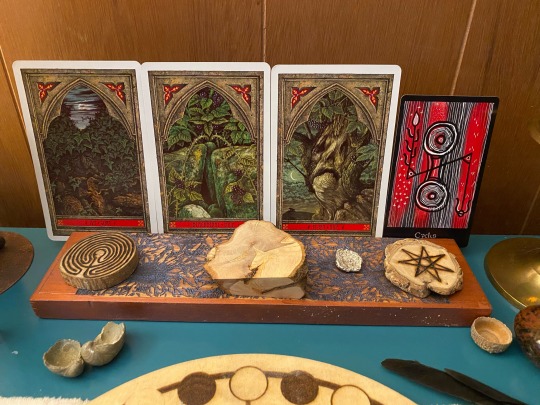
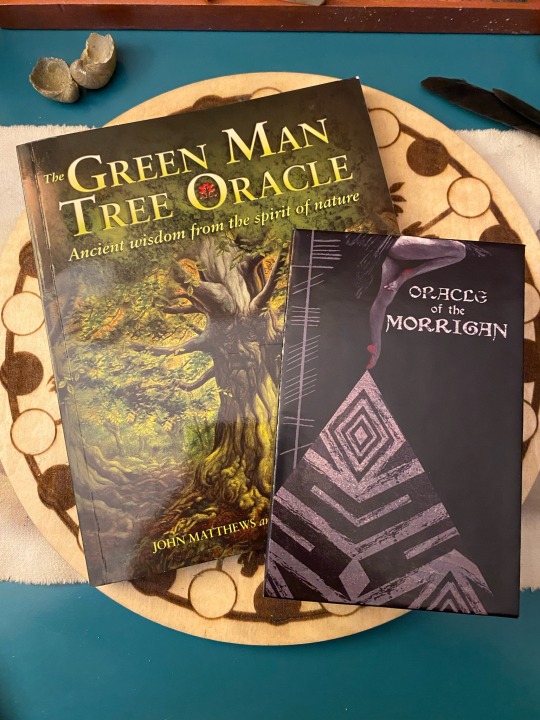
and I also struggle to understand my self-readings. I worry for bad news, I worry for bias, I worry for missing something. And yet, I still feel called to perform readings, particularly in the times of strife I’m experiencing now. I actually performed this reading the night of my birthday — a yearly tradition.
I mainly use John Matthew and Will Worthington’s Green Man Tree Oracle, which is just a illustrated ogham deck and even includes the Forfeda. Saturday’s reading was as follows:
Ivy / Gort - Call upon those around you.
Vine / Muin - Consider what you hold dear; learn to let go.
Elder / Ruis - Sometimes we must make sacrifices.
*sigh* When I most need the readings, they always rip me to shreds. Given my predisposition towards hyper-independence, I know that I am being called not only to draw from my community for support, but also, given the difficulties I am experiencing, think about what matters most in these times and understand that, even if I have to give up what I want most at this time, that the blessings after such a sacrifice may increase.
It doesn’t feel fair, but I know there is truth in it. It hurts to hear when I spent so many year in deep material and emotional insecurity. I was beginning to resent this reading. What happened to my “protection” and safety I thought my first ogham reading had assured me I’d had in drawing Rowan / Luis two years ago? Just when I thought I was finally reaching stability, it all falls away before me.
I thought of The Morrigan, too. Chiefmost among her signs to me has been Elder / Ruis. It is how she lets me know she is near and watching. Thrice now I have found it growing in places dear and sacred to me. But it almost never comes up in my readings. The first and only other time I have pulled Elder was in the reading I performed for myself in September, when I began my dedications to and preparations for joining The Order of the Morrigan. At that time, I understood it to be confirmation of what she wanted of me, but perhaps it was also a warning of what was to come and something for which she was trying to prepare me.
Now I pull Elder again, when I know exactly what sacrifices are being asked of me. It is not necessarily a physical sacrifice or a sacrifice to the Morrigan, but a sacrifice of something towards which I had worked hard and which I may now need to put off in favor of focusing on what matters most. I almost resent this, too.
I admit that in working with the Morrigan, I fear being tested. I loathe the idea of a god testing my faith and resolve. Perhaps others are comfortable with it, as is their prerogative, but given my own religious trauma, I feel it is a breech of trust and mutual faith, and it is a boundary I have sought to set with the Morrigan since making my dedication. Was she testing me now? Or was she punishing me? That, too, I loathed, because as much as I reflect, I struggle to think of what I could have done and how to make amends.
I required clarity. Thus, I pulled from my Oracle of the Morrigan illustrated by Morrigan Oran. I had officially dedicated this tool to the Morrigan earlier in the week during the full moon, and I was nervous about my ability to interpret the abstract symbolism, but I needed clarity from the Great Queens herself. She would want me to stretch my oracular skills.
After shuffling the deck several times with my question in mind, I pulled the “Cycles” card. I took a long, hard stare at the card and read the little booklet’s entry, which the illustrator had channeled in her creation of the artwork. At first, I was only more frustrated at the vagueness. But soon enough, at least one meaning dawned on me, and it was almost as if I could hear the Morrigan saying,
This is all part of a Cycle. There will always be bad times. Neither you nor I can prevent them all, no matter how much you pray or what sacrifices you make. It is the way of things.
Though I still worry for bias, I found this comforting. Perhaps I am not actually being tested or punished. Perhaps this is not more of the same through which I have struggled in the years prior and against which I have been bracing. Perhaps I am just in a bad spot, and I can and will pull through.
I suppose I have the skills and resources on which to pull. I want to put my faith in this reading and find the will and confidence to keep moving and accept the sacrifices I must make. I am scared to, but I know I can.
0 notes
Note
https://www.tumblr.com/panthera-dei/724369328778149888/im-kinda-surprised-that-this-isnt-common
This says buckthorn not blackthorn. And while buckthorn is a Eurasian tree, you almost certainly have seen it (“have access to it”) in person, because it’s heavily invasive (and ecologically destructive) in North America from landscape plantings escaped.
I appreciate your feedback. That was definitely an oversight on my part. Many traditional lists do say "blackthorn," although some say "buckthorn" instead.
Regardless, the exact details of the example are less relevant to me than the point I was trying to make.
While I may have encountered either tree at some point, neither of them are trees I readily would recognize in the wild - and as you pointed out, they aren't native or naturalized species to this area (native species being plants like juniper, which have grown here for millennia, and naturalized species being like dandelions, which aren't native but fit into the local ecosystem and provide benefits for native species). Additionally, while they certainly do sound invasive and problematic, they still aren't overly widespread in my patch of the USA - at least not yet - whereas other invasive species like Bradford pears are more likely to be found in local forests here.
In my experience, it's been more beneficial for folks to look for plants and trees that *are* local species and/or are relevant to their area. Buckthorn is not overly relevant to my area. Locust trees, however, have similar properties and have been used & cultivated here for centuries. So for a local solitary Druid, it makes more sense to work with locust and focus on that correspondence. Likewise, locust trees are highly invasive in Europe (especially honey locusts) and they have almost no history there, so a person from Europe would probably have an entirely different view of them.
Even species that do fit into the traditional Ogham - something like a honeysuckle or ivy, for example - can vary wildly from region to region. And folks who live in, say, Brazil may have a totally different view of some plants or characteristics than I do. And I think, for some folks, incorporating those personal/local perspectives can be very useful to one's practice.
Naturally, that idea isn't going to appeal to everyone, and that's ok. The traditional correspondences for the Ogham, in all their forms, are 100% valid too. I personally use either or both, depending on the situation, in my personal practice as a revivalist. ^^
0 notes
Text
The wyrd thing about my Ogham I drew myself across from Dustin was up/overall theme for me was Ivy, past/left was something about looking into my heart to find the answer, the right/future was the path/mountain meaning my kingdom will come, and present a couple days ago was thorns and Dustin was inverted from me
0 notes
Text
Gort
Ivy
Modern Letter: G Ruler of the 11th Lunar Month 30th September – 27th October
In divination Gort refers to spreading growth and wandering, the search for the self and inner soul. Just as the roots of the Ivy extend into the ground in search of nourishment and its vines extend to the light above so we seek nourishment and enlightenment. Look inward for self development and outward for…

View On WordPress
2 notes
·
View notes
Text
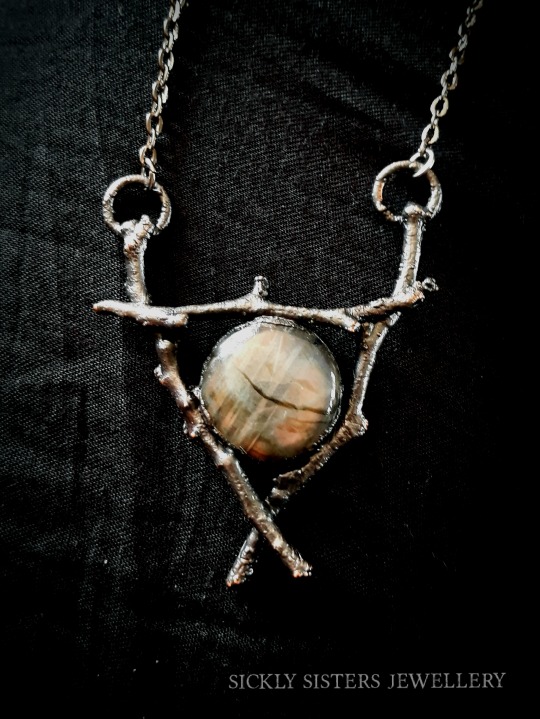
Real ivy branches encased in copper, with a labradorite. I was almost heartbroken to sell this piece. The witch who now wears it carries the strong, determined power of the ivy plant.
#sickly sisters#witchcraft#wicca#pagan#ivy plants#labradorite pendant#the tree ogham#hedgewitch#forest witch#strega#dark mori#gothic fashion#the goddess#samhain
54 notes
·
View notes
Photo

October is the month that Ivy is the strongest, and it is my sign. It is Gort in the Ogham alphabet and is known as the survivor sign. Though Ivy may look weak and fragile, and its leaves are easy to tear away, it will continue to grow and spiral until it can overcome the tallest trees and any obstacles. I have felt that. Over the last couple of months I have felt like I have been stripped down to the bone. Worn away to a nub, burned to ash. I am beginning to see how insane things were for me. . At the same time, however, I know a lot of what was stripped away was dead and no longer necessary. I have space to grow anew and I will not be held back by what is no longer relevant. I will continue 12:12:12. I went to the space for the next one yesterday and it is perfect. Stripped back and gorgeous, a wonderful gallery on Dundas West. . I know that this has been a year of struggle for many people. I know many of my friends have had their confidence knocked in one way or another and I want you to know, it does not diminish you. You are here. We are here. You will endure. I promise you that. 💜 . This Sunday, Dundas west, pay what you want. There will be stories and music and candles and friends. . . . #121212 #vancorvidxzodiac #vancorvid #violinist #violin #ivy #ogham #gort #burning #strength #artery #artist #art #gallery #dundaswest (at Toronto, Ontario) https://www.instagram.com/p/B316sJynu3z/?igshid=l6lardikn4xp
#121212#vancorvidxzodiac#vancorvid#violinist#violin#ivy#ogham#gort#burning#strength#artery#artist#art#gallery#dundaswest
1 note
·
View note
Photo

Ivy Ogham design with wood burning and painting. See it @earthen_hearth www.earthenhearth.art #ogham #gort #druidry #paganwoman #pagandecor #pagansofinstagram #pagan #ivy #pipesmoking #pipeforsmoking #celticart #irish (at Tucson, Arizona) https://www.instagram.com/p/CAJTF_hn-iW/?igshid=h0hanyyx77d2
#ogham#gort#druidry#paganwoman#pagandecor#pagansofinstagram#pagan#ivy#pipesmoking#pipeforsmoking#celticart#irish
0 notes
Photo

Ivy Gort: The Searcher, The Connecting Tree Lunar month: September 30th to October 27th Colour: Indigo Stone: Opal Element: water Animal: Butterfly, Bees Meaning: Bind and entwine, Lesson of Ivy: Learn when to let go
9 notes
·
View notes
Text

Gort (hear pronunciation) is the second letter of the third aicme (or grouping of letters) of the ogham alphabet.
Medieval kennings/Bríatharogaim/Word oghams
Milsiu féraib - “sweetest grass” from the Bríatharogam Morann mic Moín
Ined erc - “suitable place for cows” from the Bríatharogam Mac ind Óc
Sásad ile - “sating of multitudes” from the Bríatharogam Con Culainn
Other associations
Tree/Plant: Ivy
Bird: Swan
Color: Blue
More about ogham
An Introduction to Ogham
The Entire Ogham Series
The Ogham Tract (the primary source for all this info)
#Gort#ogham#ogam#irish legends#irish mythology#witchcraft#divination#divination witch#pagan#celtic pagan#celtic paganism#celtic#irish#irish pagan#irish paganism#divination tools#divination community#baby witch#beginner witch#druid#druidry#witch tips#ogham series#witchblr#ogham introduction#ogham study guide
9 notes
·
View notes
Text
Plant info-dumping
The people of Ireland have always had a deep and meaningful connection with the land and the many species of plants that live there.
Rowan and ash were the trees most commonly associated with the Sidhe or other supernatural beings. Rowan branches were tied to the tails of livestock around the holiday of Beltaine to protect against faeries. Ash trees are commonly found growing around natural or human-made wells which adds to the holy connotations of this tree.
Interestingly, and ancient Celtic language of Ogham is actually based heavily in trees. Each character represents a different species of tree native to Europe. The name of the letter is also the name of the tree. Birch is the first in the alphabet and the character and tree is called Beith. The importance of trees to ancient people is evident by the inclusion of them in their alphabet.
Another interesting plant we learned about was nettle. Nettle is a member of the mint family and primarily grows in riparian areas. It is most well known for its needle-like structures on its leaves and stems that inject an irritating toxin into anything that comes into contact with it. Stinging nettle grows in Kentucky as well, so I have been stung many times over the years. It’s really not that bad. It was so interesting to see the overlap between European and North American plants, especially considering some of the most invasive species in the U.S. come from Europe. It was so nice to see ivy, wild garlic, dandelions, chickweed, vinca, and other plants I am familiar with in Kentucky in their native homelands. While stinging nettle can be inconvenient, it is a very useful plant to humans. (While this doesn’t affect its intrinsic value as a species, it is convenient.) Nettle is edible when cooked, and it is much more nutrient dense than many other leafy greens. It was useful during starving times for its high iron content. After our lecture, we ate nettle soup from a local café! It was fantastic and such a treat to deepen my connection to the land. Dock is another plant that also grows in Ky, and it is used to treat nettle stings. Conveniently, it is often found growing near nettle! Denise said that she had not found it to be particularly effective, with plantain being the better choice for soothing stings.
Our time at the herb farm was definitely one of my favorite days, and talking with a kindred spirit like Denise and communing with the plants was much needed to sooth my soul.
4 notes
·
View notes
Text
Elements Series: Earth Correspondences

🌳 System: Earth, Saturn, Venus
🌳Zodiac: Capricorn, Taurus, Virgo
🌳Season: Winter
🌳Celebrations: Earth Day, Hunting the Wren, Yule
🌳Time of Day: Midnight
🌳Ogham: Ioho
🌳Runes: Is, Tyr, Ur
🌳Direction: North
🌳Colors: Black, Brown, Green, White
🌳Chakra: Root
🌳Energy: Yin
🌳Numbers: 4,6, 8
🌳Tarot: Pentacles
🌿Trees: Ash, Blackthorn, Cedar, Cypress, Elder, Elm, Holly, Juniper, Locust, Magnolia, Maple, Oak, Olive, Pine, Pomegranate, Rowan, Spruce, Witch Hazel
Plants: Comfrey, Fern, Honeysuckle, Ivy, Jasmine, Mugwort, Primrose, Sage, Vervain, Cinquefoil, Clove, Grains, Henbane, High John, Horehound, Mandrake, Patchouli, Reed
🌿Crystals: Agate, Alexandrite, Amazonite, Amber, Andalusite, Apophyllite, Black Coral, Green Calcite, Cat's Eye, Cerussite, Chrysocolla, Chrysoprase, Diopside, Emerald, Fluorite, Hematite, Jade, Jasper, Jet, Kunzite, Malachite, Moss Agate, Peridot, Petrified Wood, Rutilated Quartz, Salt, Smokey Quartz, Staurolite, Sugilite, Black Tourmaline, Brown Tourmaline, Green Tourmaline, Watermelon Tourmaline, Turquoise, Unakite
🌿Metals: Lead, Mercury
🌿Angels: Gabriel, Auriel
🌿Goddesses: Anat, Ariadne, Artemis, Asherah, Bertha, Ceres, Demeter, Gaia, Kore, Nephthys, Persephone, Rhea, Rhiannon
🌿Gods: Adonis, Arawn, Cernunnos, Dionysus, Geb, the Green Man, Khnum, Marduk, Mimir, Pan, Prometheus, Vishnu
🌿Animals: Antelope, Armadillo, Badger, Bear, Boar, Buffalo/Bison, Cattle, Stag, Dog, Elephant, Goat, Groundhog, Hippo, Jaguar, Mole, Otter, Pig, Prairie Dog, Wolverine, Blue Jay, Chicken, Crow, Goose, Sparrow, Swan, Turkey, Woodpecker, Crocodile, Snake, Toad, Tortoise, Turtle, Dragonfly
🌿Mythical Creatures: Dragon, Selkies
🌾 Ritual Tool: Pentacle
🌾Sense: Touch
🌾Principle: To Be Silent
🌾Issues and Intentions: Abundance, Acceptance, Agriculture, Anxiety, Balance, Beginnings, Business, Comfort, Communication, Blessing and Consecration, Consciousness, Creativity, Cycles, Death, Endurance, General Energy, Receptive Energy, Family, Fertility, Gentleness, Grounding, Growth, Healing, Hexes, the Home, Justice, Life, Dragon Magic, Manifestation, Money, Nurture, the Otherworld/Underworld, Patience, Peace, Pregnancy and Childbirth, Prosperity, Protection, Purpose, Rebirth/Renewal, Relationships, the Senses, Sensuality, Sexuality, Nature Spirits, Stability, Strength, Success, Support, Travel, Warmth, Wealth, Weather, Well-Being, Willpower, Wisdom
88 notes
·
View notes